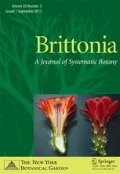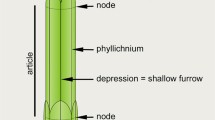Abstract
Elaphoglossum amygdalifolium holds a critical phylogenetic position as sister to the remaining ca. 600 extant species of Elaphoglossum and may provide important insight into the evolution of epiphytism in this clade of ferns. Here, we present the first examination of growth habit and gametophyte morphology for this species. We show that the cordate to elongate-cordate gametophytes occur up to 0.5 m above the ground on the base of tree trunks. Unlike the gametophytes of all other studied species of Elaphoglossum, rhizoids are absent along the thallus margin and the hairs present on the margin lack whitish waxy caps; both differences are pleisiomorphic for the genus. Sporelings of E. amygdalifolium produce a single long root that grows straight into the soil where it branches profusely. Mature sporophytes have long-creeping rhizomes that climb to heights of at least 3 m and produce two types of roots: “feeding roots” that reach the ground and “clasping roots” that anchor the sporophyte to its host plant. Our observations reveal that E. amygdalifolium is a primary hemiepiphyte, the first example of this growth habit to be documented in Elaphoglossum. Results of an ancestral state reconstruction of growth habit in bolbitidoid ferns show that both primary hemiepiphytism and holoepiphytism are equally likely to be the ancestral character state for Elaphoglossum.
Resumen
Elaphoglossum amygdalifolium mantiene una posición filogenética importante como especie hermana de las casi 600 restantes que componen el género Elaphoglossum y puede proporcionar información importante sobre la evolución del epifitismo en este clado de helechos. A continuación, se presenta el primer análisis del hábito de crecimiento y la morfología del gametofito de esta especie. Los gametofitos en formas varían de cordadas a ligeramente alargado-cordadas se presentan en la base de los troncos de los árboles hasta los 0.5 m del suelo. A diferencia que las otras especies estudiadas de Elaphoglossum, rizoides son ausentes por el margen del tallo y los pelos presentes en el margen carecen de capas cerosas blanquecinas. Los esporofitos jóvenes de E. amygdalifolium producen una sola raíz larga que crece directamente hacia el suelo. Los esporofitos maduros tienen rizomas largamente rastreros que trepan hasta una altura de por lo menos 3 m y producen “raíces nutricias” que crecen directamente hacia el suelo y “raíces abrazadoras” que anclar la planta al tronco. Nuestras observaciones revelan que E. amygdalifolium es una hemiepífita primaria, el primer ejemplo de este hábito de crecimiento que se documenta en Elaphoglossum. Los resultados de una reconstrucción del estado ancestral del hábito de crecimiento en Elaphoglossum, muestran que tanto el hemiepifitismo primario como el holoepifitismo tienen la misma probabilidad de ser el carácter ancestral para el género.





Similar content being viewed by others
Literature Cited
Atkinson, L. R. 1973. The gametophyte and family relationships. Pp. 73–90. In: A. C. Jermy, J. A. Crabbe & B. A. Thomas (eds.). The phylogeny and classification of ferns. Botanical Journal of the Linnean Society 67 (Suppl. 1). [also published as a book by Academic Press, New York]
Benzing, D. H. 1990. Vascular epiphytes. Cambridge University Press, Cambridge.
Chiou, W., D. R. Farrar & T. A. Ranker. 1998. Gametophyte morphology and reproductive biology in Elaphoglossum. Canadian Journal of Botany 76: 1967–1977.
Gay, H. 1993. The architecture of a dimorphic clonal fern, Lomagramma guianensis (Aublet) Ching (Dryopteridaceae). Botanical Journal of the Linnean Society 111: 343–358.
Grayum, M. H. & H. W. Churchill. 1989. The vascular flora of La Selva Biological Station, Costa Rica, Polypodiophyta. Selbyana 11: 66–118.
Holttum, R. E. 1932. On Stenochlaena, Lomariopsis and Teratophyllum in the Malayan Region. The Gardens’ Bulletin Straits Settlements 5: 245–313.
———. 1937. The genus Lomagramma. Gardens' Bulletin Straits Settlements 9: 190–221.
———. 1966. The genera Lomariopsis, Teratophyllum and Lomagramma in the islands of the Pacific and Australia. Blumea 14: 215–223.
———. 1978 Lomariopsis group. Pp. 255–330. In: G. G. J. van Steenis & R. E. Holttum (eds.). Flora Malesiana, series 2, Pteridophyta, ferns and fern allies. Volume 1, part 4.
Kramer, K. U. & P. S. Green. 1990. The Families and Genera of Vascular Plants, Volume 1: Pteridophytes and Gymnosperms. Berlin: Springer-Verlag.
Maddison, W. P. & D. R. Maddison. 2010. Mesquite: a modular system for evolutionary analysis. Version 2.73. http://mesquiteproject.org.
Mickel, J. T. 1995. Elaphoglossum. Pp. 250–283. In: G. Davidse, S. Knapp & M. Sousa (gen. eds.), and R. C. Moran & R. Riba (vol. eds.), Flora Mesoamericana, Volume 1, Psilotaceae a Salviniaceae. Universidad Autónoma de México, Ciudad Universitaria.
——— & L. Atehortúa G. 1980. Subdivision of the genus Elaphoglossum. American Fern Journal 70: 47–68.
Moran, R. C., P. H. Labiak & M. Sundue. 2010a. Phylogeny and character evolution of the bolbitidoid ferns (Dryopteridaceae). International Journal of Plant Sciences 171: 547–559.
———, ––––– & –––––. 2010b. Synopsis of Mickelia, a newly recognized genus of bolbitidoid ferns (Dryopteridaceae). Brittonia 62: 337–356.
Nayar, B. K. & S. Kaur. 1971. Gametophytes of homosporous ferns. Botanical Review 37: 295–396.
Nitta, J. H. & M. J. Epps. 2009. Hemiepiphytism in Vandenboschia collariata (Hymenophyllaceae). Brittonia 61: 392–297.
Pérez-García, B. & I. R. Jaramillo. 1990. Desarrollo del gametofito de Elaphoglossum petiolatum (Sw.) Urban (Lomariopsidaceae). Acta Botánica Mexicana 10: 23–30.
Rouhan, G., J.-Y. Dubuisson, F. Rakotondrainibe, T. J. Motley, J. T. Mickel, J. N. Labat & R. C. Moran. 2004. Molecular phylogeny of the fern genus Elaphoglossum (Elaphoglossaceae) based on chloroplast non-coding DNA sequences: contributions of species from the Indian Ocean area. Molecular Phylogenetics and Evolution 33: 745–763.
Sánchez-Montiel, L., M. de la Luz Arreguin-Sánchez & R. Fernández-Nava. 2008. Gametofitos y esporofitos jóvenes de dos pteridofitas: Asplenium monanthes L. (Aspleniaceae-Pteriophyta) y Elaphoglossum minutum (Pohl ex Fée) T. Moore (Lomariopsidaceae-Pteridophyta). Polibotánica 25: 29–43.
Schuettpelz, E. & K. M. Pryer. 2007. Fern phylogeny inferred from 400 leptosporangiate species and three plastid genes. Taxon 56: 1037–1050.
Stokey, A. G. & L. R. Atkinson. 1957. The gametophytes of some American species of Elaphoglossum and Rhipidopteris. Phytomorphology 7: 275–292.
Acknowledgments
Fieldwork was completed during the 2010 Tropical Plant Systematics course sponsored by the Organization for Tropical Studies and taught by the junior author and Brad Boyle. We thank OTS personnel Barbara Lewis, Liana Barbar, and Guiselle Castro for helping make this course possible. Joel Nitta and Jean-Yves Dubuisson provided helpful reviews of the manuscript. Alejandra Vasco kindly translated the abstract into Spanish. Figure 1 was drawn by Haruto Fukuda. This research was partially supported by a grant to R. C. Moran from the United States National Science Foundation (DEB-1020443).
Author information
Authors and Affiliations
Corresponding author
Rights and permissions
About this article
Cite this article
Lagomarsino, L.P., Grusz, A.L. & Moran, R.C. Primary hemiepiphytism and gametophyte morphology in Elaphoglossum amygdalifolium (Dryopteridaceae). Brittonia 64, 226–235 (2012). https://doi.org/10.1007/s12228-011-9216-y
Published:
Issue Date:
DOI: https://doi.org/10.1007/s12228-011-9216-y




